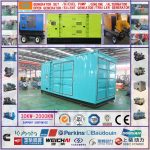Optimizing Diesel Generators for High-Altitude Operations
Introduction
Diesel generators are indispensable sources of power in various applications, providing reliable electricity in both emergency and continuous power scenarios. While these workhorses of the energy industry are known for their robustness and versatility, their performance can be significantly impacted when operating at high altitudes. In this article, we explore the challenges faced by diesel generators at high elevations and delve into the strategies and technologies used to optimize their performance in such environments.
Challenges of High-Altitude Operation

High-altitude locations present unique challenges for diesel generators due to the following factors:
1. Reduced Air Density: As altitude increases, the air density decreases, leading to lower oxygen levels. Diesel engines require a precise air-to-fuel ratio for combustion, and the reduced oxygen content can result in incomplete combustion, reduced power output, and increased fuel consumption.
2. Cooling Efficiency: High-altitude environments often have lower air pressure and temperatures, which can impact the cooling systems of diesel generators. Inadequate cooling can lead to overheating and reduced efficiency of the engine.
3. Fuel Combustion: The combustion process in diesel engines relies on a precise mix of air and fuel. At high altitudes, the reduced oxygen levels can affect the combustion process, leading to incomplete burning of fuel and increased emissions.
4. Turbocharger Performance: Many modern diesel generators are equipped with turbochargers to compensate for the reduced air density at high altitudes. However, turbochargers can also be affected by the lower air pressure, impacting their efficiency and overall engine performance.
Optimizing Diesel Generators for High-Altitude Operations
To overcome the challenges of operating diesel generators at high altitudes, several optimization strategies and technologies can be employed:
1. Engine Design: Manufacturers are increasingly designing diesel engines specifically for high-altitude operations. These engines are equipped with features such as high-pressure turbochargers, advanced fuel injection systems, and optimized combustion chambers to ensure optimal performance at altitude.
2. Turbocharger Technology: Turbochargers play a crucial role in maintaining engine performance at high altitudes by compressing air before it enters the combustion chamber. High-altitude optimized turbochargers are designed to operate efficiently in low-pressure environments, ensuring consistent power output.
3. Fuel Injection Systems: Advanced fuel injection systems with precise control mechanisms can help optimize fuel combustion in diesel engines at high altitudes. Electronic fuel injection systems adjust the fuel-to-air ratio based on altitude and load conditions, improving efficiency and reducing emissions.
4. Cooling diesel generator efficiency : Efficient cooling systems are essential for diesel generators operating in high-altitude environments. Enhanced radiator designs, auxiliary cooling fans, and temperature sensors can help maintain optimal engine temperatures and prevent overheating.
5. Air Intake Systems: To ensure adequate air supply to the engine, high-altitude diesel generators are equipped with optimized air intake systems. Filters, ducting, and intake manifolds are designed to maximize airflow and minimize pressure losses, improving engine performance.
6. Altitude Compensation: Some diesel generators feature altitude compensation systems that automatically adjust engine parameters based on altitude levels. These systems can optimize fuel delivery, turbocharger performance, and cooling efficiency to ensure consistent power output at varying altitudes.
7. Remote Monitoring and Control: Remote monitoring and control systems enable operators to monitor the performance of diesel generators in real-time and make adjustments as needed. These systems can provide valuable insights into engine parameters, fuel consumption, and maintenance requirements, allowing for proactive management of high-altitude operations.
Conclusion
Operating diesel generators at high altitudes presents unique challenges that require specialized solutions and technologies. By optimizing engine design, turbocharger technology, fuel injection systems, cooling systems, air intake systems, altitude compensation, and remote monitoring capabilities, operators can ensure reliable and efficient power generation in high-altitude environments. As the demand for electricity continues to rise in remote and mountainous regions, the importance of optimizing diesel generators for high-altitude operations cannot be overstated. By staying abreast of the latest advancements in diesel generator technology and implementing best practices for high-altitude operation, operators can maximize the performance and reliability of their power generation systems in challenging environments.